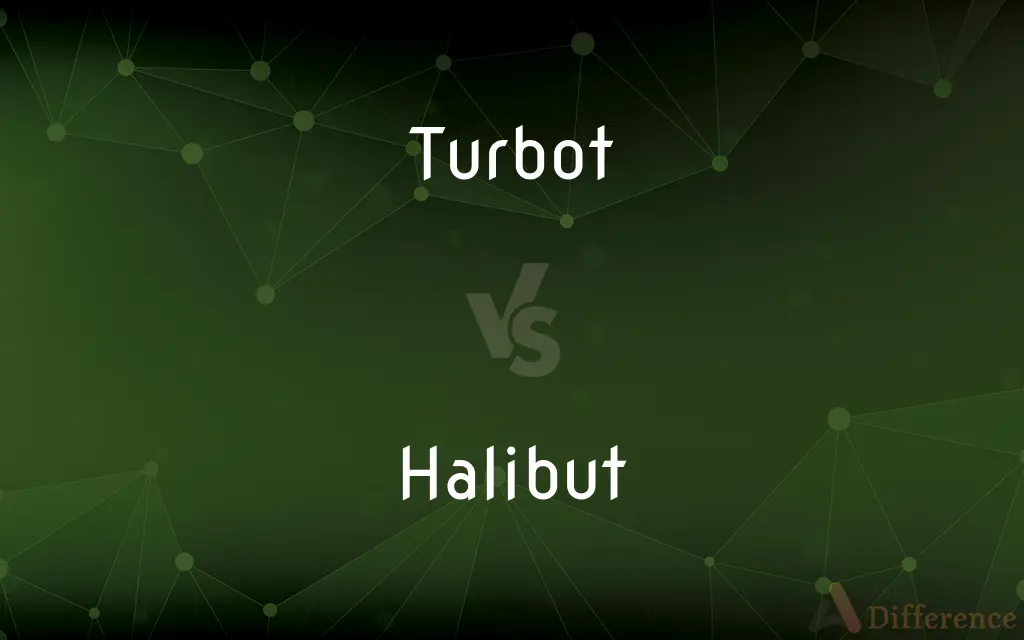Turbot vs. Halibut — What's the Difference?
Edited by Tayyaba Rehman — By Fiza Rafique — Updated on November 2, 2023
Turbot is a flatfish found in European waters, while halibut is a larger flatfish found in the North Pacific and North Atlantic.

Difference Between Turbot and Halibut
Table of Contents
ADVERTISEMENT
Key Differences
Turbot, a species belonging to the family Scophthalmidae, is a flatfish prized in Europe for its delicate flavor. It has a smooth, slippery skin and is often found in the sandy, muddy bottoms of the North Atlantic and the Mediterranean Sea. On the other hand, halibut belongs to the family Pleuronectidae and includes the Atlantic and the Pacific varieties, known for being some of the largest flatfish species. Halibut is sought after for its firm, white flesh and is common in colder waters.
Turbot is distinctive for its almost circular body shape and lack of tubercles on the dark side of its skin. In contrast, halibut is more elongated and diamond-shaped, with both eyes on the darker side that can have small bumps or tubercles. While turbot is usually smaller in size, a halibut can grow to be much larger, with Pacific halibut reaching several hundred pounds.
In culinary contexts, turbot is renowned for its smooth texture and is often served whole or filleted in high-end restaurants. Halibut's meat is leaner and can be cooked in various ways, making it a versatile ingredient in many recipes. Its larger size means it's commonly available as steaks or fillets and can be found in markets around the world.
When it comes to commercial fishing, turbot is often farmed, leading to a more consistent supply, though wild turbot is considered superior in taste. Halibut, especially the Pacific variety, is a significant commercial fishery and is managed to prevent overfishing. Halibut fishing has strict regulations due to their slow growth and late maturity.
Conservation status is another point of difference; some turbot populations are at risk due to habitat disturbance and overfishing. Meanwhile, halibut, particularly the Pacific halibut, has a success story with sustainable fishery management practices in place to help maintain its populations.
ADVERTISEMENT
Comparison Chart
Scientific Family
Scophthalmidae
Pleuronectidae
Habitat
North Atlantic, Mediterranean
North Pacific, North Atlantic
Body Shape
Almost circular
Elongated, diamond-shaped
Size
Smaller, usually up to 3 feet
Larger, can exceed 8 feet
Texture and Taste
Delicate, smooth texture
Firmer, lean meat
Compare with Definitions
Turbot
A flatfish found in European waters.
The chef prepared a roasted turbot for the main course.
Halibut
The largest species of flatfish.
The Pacific halibut can weigh hundreds of pounds.
Turbot
A valuable and esteemed food fish in Europe.
Turbot is a favorite among seafood connoisseurs.
Halibut
A popular fish in both commercial and recreational fishing.
The season for halibut fishing is highly anticipated.
Turbot
A marine fish with a sandy or olive-green top side.
Turbot is often camouflaged against the ocean floor.
Halibut
A large flatfish of the genus Hippoglossus.
Fishermen regard halibut as a prized catch due to its size.
Turbot
A fish with a high market price due to its taste.
At the auction, the turbot fetched a high price.
Halibut
A lean fish with mild, sweet-tasting white flesh.
Halibut is often used in fish and chips for its firm texture.
Turbot
A flatfish species with a near-circular body.
The turbot's unique shape makes it easily recognizable.
Halibut
Halibut is the common name for three flatfish in the genera Hippoglossus and Reinhardtius from the family of right-eye flounders and, in some regions, and less commonly, other species of large flatfish. The word is derived from haly (holy) and butte (flat fish), for its popularity on Catholic holy days.
Turbot
The turbot (Scophthalmus maximus) is a relatively large species of flatfish in the family Scophthalmidae. It is a demersal fish native to marine or brackish waters of the Northeast Atlantic, Baltic Sea and the Mediterranean Sea.
Halibut
Any of several large edible flatfishes of the genus Hippoglossus and related genera, of northern Atlantic or Pacific waters.
Turbot
A flatfish, Psetta maxima syn. Scophthalmus maximus, of marine and brackish waters of Europe and North Africa, having a brown knobby upper side and prized as food.
Halibut
A large flatfish of the genus Hippoglossus, which sometimes leaves the ocean floor and swims vertically.
Turbot
Any of various flatfishes or other fishes that are similar to this fish.
Halibut
A large, northern, marine flatfish (Hippoglossus vulgaris), of the family Pleuronectidæ. It often grows very large, weighing more than three hundred pounds. It is an important food fish.
Turbot
A species of flatfish native to Europe (Scophthalmus maximus, earlier Psetta maxima).
Halibut
Lean flesh of very large flatfish of Atlantic or Pacific
Turbot
Any of various other flatfishes of family Scophthalmidae that are found in marine or brackish waters.
Halibut
Marine food fish of the northern Atlantic or northern Pacific; the largest flatfish and one of the largest teleost fishes
Turbot
Triggerfish, Canthidermis sufflamen.
Halibut
A bottom-dwelling fish commonly found in cold waters.
Divers spotted a halibut on the sea bed during their cold-water dive.
Turbot
A large European flounder (Rhombus maximus) highly esteemed as a food fish. It often weighs from thirty to forty pounds. Its color on the upper side is brownish with small roundish tubercles scattered over the surface. The lower, or blind, side is white. Called also bannock fluke.
Turbot
Flesh of a large European flatfish
Turbot
A large brownish European flatfish
Common Curiosities
How big can halibut get?
Pacific halibut can grow over 8 feet long and weigh several hundred pounds.
Is turbot expensive?
Yes, turbot is considered a luxury fish and can be quite expensive.
What does halibut taste like?
Halibut has a mild, sweet taste with a firm, meaty texture.
Where can you commonly find turbot?
Turbot is commonly found in the North Atlantic and Mediterranean Sea.
What's the best way to cook halibut?
Halibut is versatile and can be grilled, baked, or fried.
Do turbot and halibut have the same texture?
No, turbot is more delicate, while halibut has a firmer, meatier texture.
Is turbot a sustainable fish?
Sustainability varies by region; some turbot fisheries are sustainable, while others are not.
Are there different types of halibut?
Yes, the two main types are Atlantic halibut and Pacific halibut.
What is the main difference between turbot and halibut?
The main differences are their habitat, size, body shape, and family.
Can you eat the skin of turbot?
Yes, the skin of turbot is edible when cooked until crispy.
Can you farm turbot?
Yes, turbot is successfully farmed in many parts of Europe.
Is halibut healthy to eat?
Yes, halibut is low in fat and a good source of protein and omega-3 fatty acids.
Are turbot and halibut related?
They are both flatfish but belong to different families.
What is the conservation status of halibut?
The conservation status varies; however, Pacific halibut is considered well-managed.
Are turbot and halibut good for sushi?
Halibut is commonly used in sushi, while turbot is less common but still suitable for sushi dishes.
Share Your Discovery

Previous Comparison
Mentor vs. Tutor
Next Comparison
Brisk vs. ColdAuthor Spotlight
Written by
Fiza RafiqueFiza Rafique is a skilled content writer at AskDifference.com, where she meticulously refines and enhances written pieces. Drawing from her vast editorial expertise, Fiza ensures clarity, accuracy, and precision in every article. Passionate about language, she continually seeks to elevate the quality of content for readers worldwide.
Edited by
Tayyaba RehmanTayyaba Rehman is a distinguished writer, currently serving as a primary contributor to askdifference.com. As a researcher in semantics and etymology, Tayyaba's passion for the complexity of languages and their distinctions has found a perfect home on the platform. Tayyaba delves into the intricacies of language, distinguishing between commonly confused words and phrases, thereby providing clarity for readers worldwide.















































